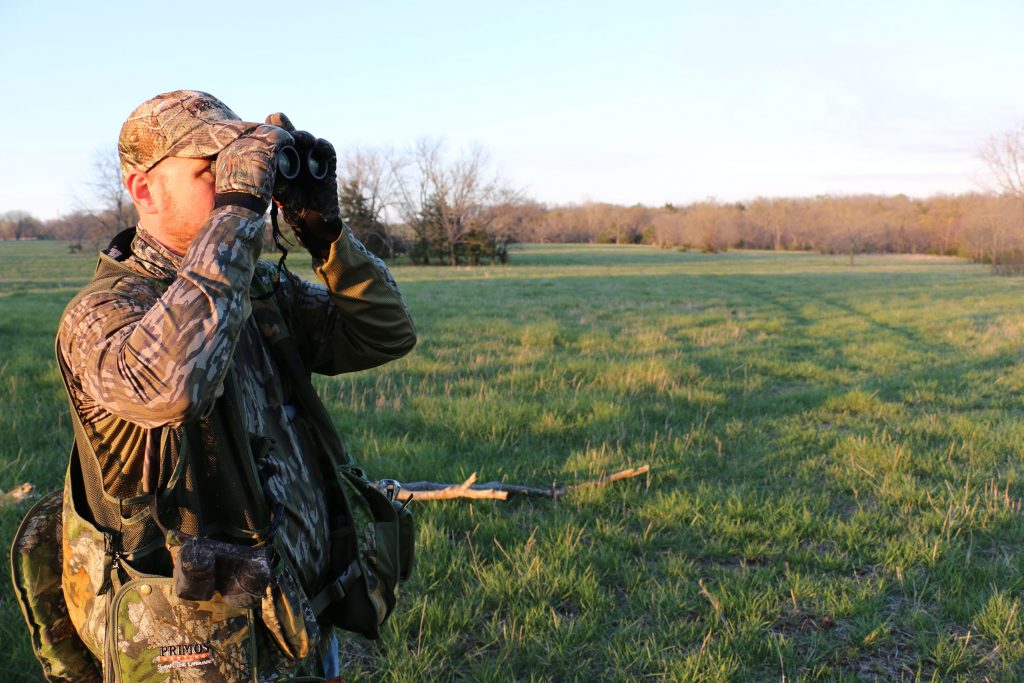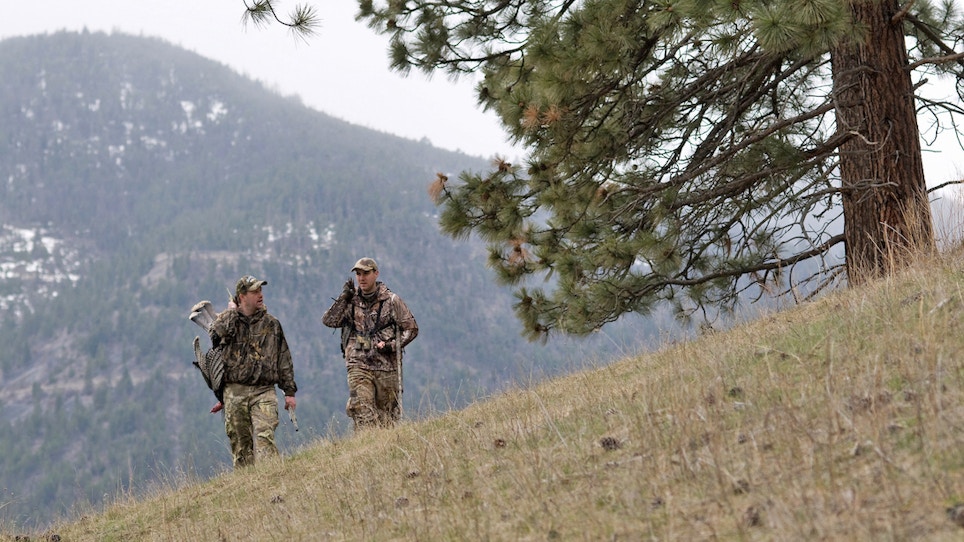Featured photo: John Hafner
Far-flung lands west of the Missouri and Mississippi rivers beckon hunters every spring, with the promise of scenic landscapes and exotic, hard-gobbling birds. But Merriam’s and Rio Grande country also holds a surprise: vast, wide-open landscapes with very few trees. To an eastern hunter accustomed to chasing gobblers in timber, that can create a tough adjustment. How quickly you adapt can make or break your once-in-a-lifetime western hunt.
The trouble with terrain
Tree-challenged landscapes present two basic problems. First, turkeys have fewer spots to roost. In fact, they’ll sometimes spend the night on small mesquite trees or even power lines in some areas of Texas. Because roost sites are limited, suitable groves and individual trees are often jammed with birds every night. In fact, these “traditional roosts” can sometimes hold more than 100 turkeys. However, these roosts are often not near prime feeding or nesting areas, so birds typically fly down in the morning and hit the open ground running. In some areas, they might cover a circuit daily of several miles before returning to a roost at night. The result? Fly-down hunts near these big roosts are often a waste of time. Yes, it’s fun to hear 100-plus turkeys at dawn, but when the birds lace up their track shoes and depart, you’d better be ready to follow.
That leads to problem No. 2. In wide-open landscapes, turkeys can pick you out several hundred yards away. Further, because they’re so mobile, those birds might go almost anywhere — river breaks, large pastures, mesquite flats, huge ag fields or similar areas. They’re often vocal, so you can usually keep track of them. However, gobbling doesn’t mean they’re coming to you, and eastern hunters quickly learn that falling in behind a group of roving, albeit noisy, western turkeys is an exercise in frustration.

Binoculars are critical in Merriam’s and Rio Grande country. Always glass your surroundings before making a move. It’s amazing how easily large black birds disappear into mesquite, prairie grass or rocky canyons.
Go big
The solution isn’t complicated. Go turkey hunting. Just be aware of and adapt to the open western surroundings. Here are seven tips:
1. Glass Often
Do this especially before you move. Binoculars are critical out West. It’s unbelievable how easily a group of large black birds can disappear in a sea of grass or a rocky canyon. Scan open areas often and thoroughly. View closer areas first and farther spots afterward. Look for anything out of place. It’s better to take a second look at a distant cedar bush than to assume it’s not a turkey.
2. Get Aggressive
When repositioning on birds, don’t be shy. This is usually the biggest mistake eastern turkey hunters make out West — they don’t move enough. That seems silly considering the open terrain, but it’s true. You must often make long, calculated end-arounds, using terrain to hide your movements, to score.
3. Get Ahead
Figure out where turkeys are going, and try to get ahead of them. Western turkeys will sometimes come a long way to calling, but it helps if you’re where they want to travel anyway. Use binoculars to find birds traipsing down a draw, into a creek bottom, across an alfalfa field or up a river break. Then, analyze the landscape, plan a hidden approach and execute it swiftly.
4. Find Subtle Features
Look for subtle features that might hide your movements, such as gulches, creeks, ridges, cedar groves or even raised road beds. If you miss the birds and they slip past, try to locate them again and form another relocation plan.
5. Call Aggressively
If you can’t visually locate turkeys, keep tabs on birds through aggressive calling, preferably with something loud and high-pitched to cut the wind, such as a box or aluminum call. Listen to gobbling to discern the travel path of a longbeard, and again, look at the terrain, plan an end-around and get moving. If you’re one draw away from where the birds go, keep contact with them via calling, and keep moving until you’re at the right spot.
6. Be Prepared to Crawl
One note: Often, you’ll have to use low-level relocation — that is, crawling — to get position on a flock without being busted. That doesn’t mean you’re bushwhacking turkeys. You’re simply using woodsmanship to remain unseen and access a good ambush site. Get after it.
7. Take Advantage of Open Spaces
If all else fails, you can use those wide-open spaces to your advantage. Remember, birds can see a long way. Break out a realistic hen decoy, and move it back and forth above the grass. Have a buddy back it up with some yelping. Or take a gobbler or jake fan, hold it high and spread it in plain sight of a longbeard. His machismo might get the best of him and prompt him to run in for a rumble. The only fight he’ll get is with 2 ounces of shot. Caveat: Only use the fan trick if you’re certain no other hunters are in the area — especially folks driving by on roads in states where turkey hunting with rifles is legal.
Think like a local
Above all, don’t be shy during a western turkey hunt. You can kill birds by yelping from likely areas, just as you would in the friendly woods back home. But it’s usually better to locate traveling turkeys and move aggressively on them, trying to get where they want to be. You’ll bump some gobblers, but that’s the great thing about the West — you’ll usually find other birds. Laugh off a mistake, switch areas, locate more turkeys and pursue them.
Before you know it, you’ll feel right at home spreading the white or buff-colored tips of a western tail fan.






